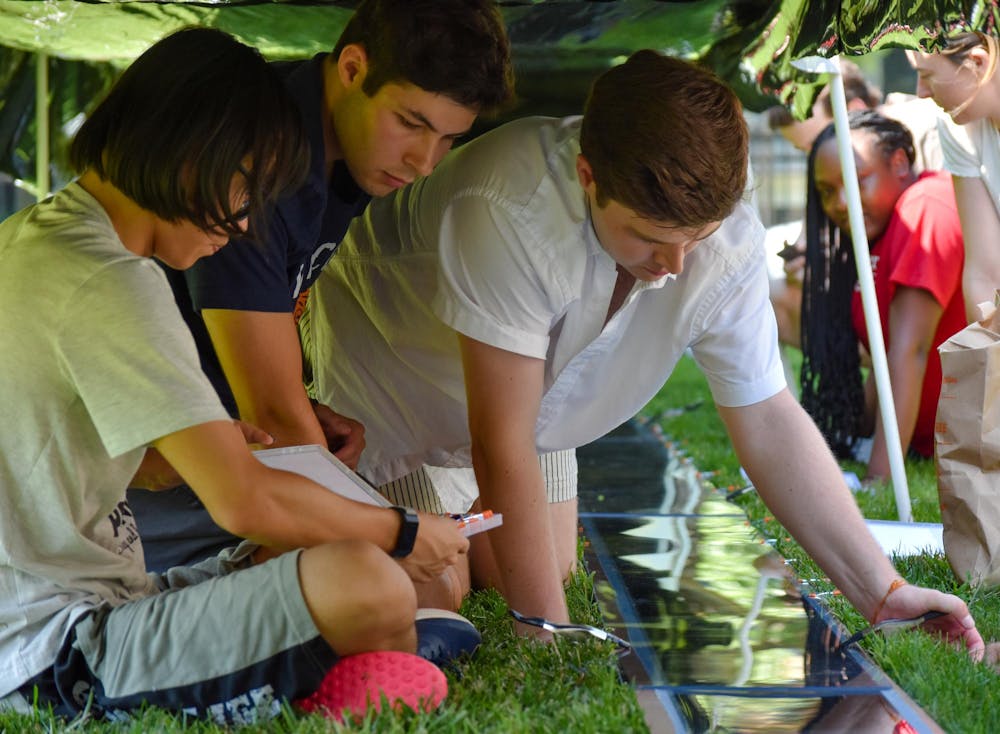Out on Pembroke Field, a group of 20 students and community members gathered around with one mission in mind. With a ten second countdown, the group counted in unison, lifting a makeshift plastic pipe table draped in a tarp, exposing a 60-foot-long sandwich of hardwood, green cyanotype-treated silk, Lunar Orbiter replication film and plexiglass to the sun.
Exactly 12 minutes later, the group covered the project with the same contraption. Logan Tullai ’25, the project’s mastermind, gathered the blue silk and rushed it to a 57-gallon bin of cold water to remove the photoreactivity from the fabric, developing the print. Then, a brigade of helpers ferried the damp silk to a nearby clothesline.
Images of the surface of the Moon fluttered in the breeze. Meanwhile, the team prepared the next roll of film.

On Aug. 27, Tullai oversaw the creation of cyanotype prints of two rolls of NASA Lunar Orbiter film. A few days later, Tullai and collaborators printed two more rolls.
Brown used to house the Northeast Regional Planetary Imaging facility — a repository for NASA data, including the reproductions of the Lunar Orbiter film — explained Ralph Milliken, associate professor of Earth, Environmental and Planetary Sciences while watching the printing process. As staff began to digitize those archives, many rolls of film were declassified, Milliken said.
While scouting safe landing locations, each of the five Lunar Orbiter missions between 1966 and 1967 shot pictures of the Moon’s surface on film, and then developed and transmitted the scanned images down to Earth, Milliken said.
“They were saved from the dumpster decades ago,” Milliken said, adding that he was glad to see them put to use.
But transforming the rolls of film took months of preparation. Tullai first acquired pieces of the Lunar Orbiter film last fall through the Multimedia Lab’s Moon Design Challenge in which student artists were encouraged to experiment and engage with decommissioned film negatives, The Herald previously reported.
The rolls that Tullai used came from Lunar Orbiter 2 in November 1966 and Lunar Orbiter 3 in February 1967.
Originally, Tullai wanted simply to take the negatives “into a darkroom and see what happens.” But as he started acquiring more rolls of film and learning about its history, he grew more interested. “The way the film came back to Earth was so dramatic,” Tullai explained. He thought a project just as grand was necessary to present the images.

While thinking about how to tackle a project of this scale, Tullai was drawn to cyanotype printing, something he learned about in his photography classes at Brown — his only formal photography training. This method uses non-toxic photoreactive chemicals and objects to create relief images.
“I thought it would be cool to use the sun’s UV to make pictures of the moon,” Tullai said.
As Tullai’s project grew in scale, so did his expenses. The project received a grant from the Brown Arts Institute which allowed him to acquire the necessary materials throughout the year, including silk and custom-made plexiglass, he said.
With all the planning, developing and shopping done, there was just one more challenge Tullai needed to overcome. “As a practical matter, it was something I couldn’t do myself,” he said with a laugh.
A number of Tullai’s friends showed up, and so did members of the Brown community.
The completed silk pieces will be displayed on campus later this fall. Tullai is still figuring out the logistics, and he has also been in conversation with NASA to exhibit the finished products in its headquarters in Washington, DC.
Currently, Tullai has 14 rolls of Lunar Orbiter film in his possession, and he is eager to continue printing and working with them.
Dana Richie is a senior staff writer for Arts and Culture and the photo chief. She enjoys using multiple forms of media to capture peoples’ stories and quirks. In her free time, she loves knitting, learning about local history and playing ultimate frisbee.





